Introduction to Tow Hitches
Towing is integral to RV travel, camping, and outdoor activities. Tow hitches allow you to transport everything from lightweight trailers to large RVs. With so many tow hitch options available, choosing the right one is critical for safety and ensuring a smooth and comfortable ride.
The wrong combination of tow hitches, trailer, and towing vehicle can lead to dangerous situations, damage to your vehicle, and a stressful towing experience.
In this guide, I’ll leverage my experience as an RV parts expert to explain the different types of tow hitches available and provide insights on selecting the right hitch for your needs. From receiver hitches to fifth wheel and gooseneck hitches, we’ll explore their uses, benefits, and critical considerations.
Note that I’ll discuss the parts that are attached to the towing vehicle in this article. While weight distribution hitches are called hitches, they don’t usually form part of the towing vehicle when a trailer is disconnected. I’ve written a detailed article on weight distribution hitches at RV Travel Life.
Receiver Hitches

Receiver hitches are the most widely used tow hitches and are highly versatile, making them a go-to option for many towing applications. Many vehicles come from the factory with receiver hitches installed.
Receiver hitches attach to the vehicle’s frame, providing a stable point for towing trailers, RVs, boats, and other loads. They are available in various classes, each designed for different load capacities.
It’s important to note that receiver hitches are almost always vehicle-specific. This means they’re designed to fit your vehicle’s unique frame configuration, so you must ensure that the hitch you choose is compatible with your car or truck.
Also, consider the vehicle’s manufacturer’s towing capacity rating first. Installing a high-weight capacity hitch will not increase the size of the trailer your car or truck was designed to pull. This is pretty hard to get wrong because the vehicle-specific receiver hitches available almost always match the towing capacity of the tow vehicle.
Suppose you are considering purchasing a vehicle for towing. In that case, you can use the following information on hitch classes to the manufacturer’s towing capacity and compare it to the trailer specifications you want to tow. This will ensure that your tow vehicle can pull the trailer safely.
Class I (Light-duty)
Class I hitches are designed for towing light loads like bike racks, small utility trailers, or kayaks. They’re often installed on small cars and crossovers with a towing capacity of around 2,000 pounds and a tongue weight limit of 200 pounds. While limited in capacity, Class I hitches are perfect for weekend adventurers who need to haul lightweight items without investing in a larger vehicle.
When considering a Class I hitch, consider how often you’ll tow and the weight of the items you plan to transport. This hitch will provide all the towing capability for most people with small cars.
Class II (Medium-duty)
Class II receiver tow hitches are the next step up, with a towing capacity of 3,500 pounds and a tongue weight limit of 350 pounds. These hitches are ideal for midsize SUVs and light trucks that need to tow slightly heavier loads, such as small campers or boats. Class II is a good option if you’re towing regularly but don’t need the power of a heavy-duty hitch.
However, like with Class I, ensure that the hitch you select is compatible with your vehicle’s frame. It’s easy to assume that a larger capacity hitch will fit any midsize SUV, but vehicle-specific mounting points mean you’ll need to check compatibility first.
Class III (Standard-duty)
Class III receiver hitches are the most commonly used hitches for RV enthusiasts. With a towing capacity of up to 6,000 pounds and a tongue weight capacity of 600 pounds, these hitches are often found on full-size SUVs, trucks, and vans. Class III hitches can handle mid-sized trailers, campers, and boats, making them an excellent option for families and outdoor enthusiasts.
In my experience, a Class III tow hitch is the most versatile option for those towing mid-size trailers or smaller RVs. It offers a good balance of capacity without being overly specialized, and most vehicles in this category have the towing power to handle it.
Class IV (Heavy-duty)
Class IV hitches provide the extra capacity to tow larger travel trailers or utility trailers. They are designed for heavy-duty trucks and vans with a towing limit of 12,000 pounds and a tongue weight limit of 1,200 pounds. They are often used for larger RVs, boats, or work trailers that require more power and stability on the road.
One advantage of Class IV hitches is their ability to handle weight distribution systems and sway control devices, making towing large loads safer and more comfortable.
Class V (Super-duty)
Class V hitches are the heavy lifters in the receiver hitch family. They can tow up to 20,000 pounds, making them ideal for commercial trailers, car haulers, or oversized RVs. Class V hitches are typically found on heavy-duty trucks and are engineered for maximum durability and performance.
Superhitch
For those who need to push the limits of towing capacity even further, the Torklift Superhitch is one of the most powerful options for tow hitches. They can tow over 30,000 pounds with the correct configuration, making it suitable for extreme towing applications. While most RVers won’t need this capacity level, it’s an excellent option for hauling heavy loads.
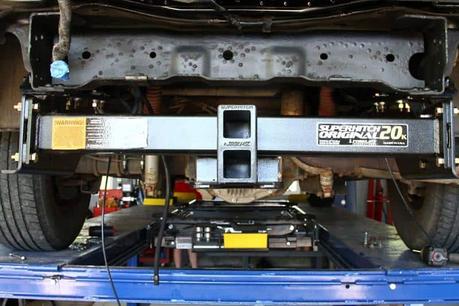
Another application for Superhitches in the RV world is for truck camper owners whose camper extends far behind their truck. By combining a Superhitch with a Supertruss extension, they can tow larger loads farther behind the pickup.
Receiver hitches are highly versatile but vehicle-specific, so always verify compatibility with your vehicle before purchasing. For RV enthusiasts, Class III and IV hitches are often the best choices, offering a good balance of capacity and versatility. Class V and the Superhitch provide the power needed to tow safely for those with larger trailers.
Fifth Wheel Hitches
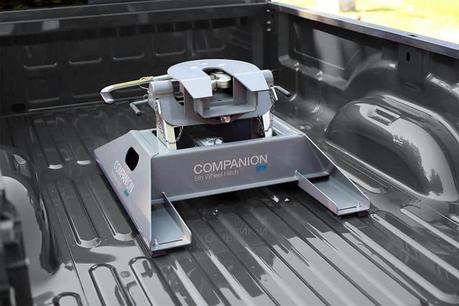
Not surprisingly, you’ll need a fifth-wheel tow hitch if you have to tow a fifth-wheel trailer. These hitches are mounted in the truck bed, offering better weight distribution and control than traditional receiver hitches. Fifth-wheel hitches are designed to handle heavy loads while providing a stable and secure connection between the truck and the trailer.
Mounting Options: ISR vs. Puck Systems
One key consideration when choosing a fifth-wheel hitch is the mounting system. There are two main types: Industry Standard Rails (ISR) and puck systems. Both systems have advantages; the best choice depends on your vehicle’s setup.
- ISR (Industry Standard Rails): ISR systems are widely used and consist of rails installed inside the truck bed. The fifth wheel hitch attaches to these rails, providing a stable connection between the truck and trailer. One downside to ISR systems is that the rails remain in the bed even when the hitch is removed, which can be inconvenient if you use your truck bed for other purposes.
- Puck Systems: Many newer trucks have puck systems built into the truck bed. These systems allow you to easily install and remove the fifth wheel hitch without leaving rails behind. Puck systems are typically more expensive but offer greater convenience, especially if you frequently switch between towing and other uses for your truck bed.
Fifth Wheel Bracket Kits and Vehicle Compatibility
Like receiver hitches, fifth-wheel hitches require vehicle-specific mounting kits. These kits attach to the frame of your truck and are designed to fit your vehicle’s make and model. Selecting the correct bracket kit for your truck is crucial, as an improper fit can lead to instability while towing.
For trucks equipped with puck systems, you can purchase a compatible fifth-wheel hitch that fits directly into the pucks. If your vehicle doesn’t have a factory-installed puck system, you’ll need an aftermarket bracket kit designed for your specific truck model.
Types of Fifth-Wheel Tow Hitches
Fixed Fifth Wheel Hitch
Fixed fifth-wheel hitches are the most straightforward option, offering a secure connection for trucks with long beds. These hitches remain stationary, providing a solid and reliable towing solution. Fixed hitches are typically used only with long-bed trucks where worrying about cab clearance when making sharp turns is not an issue.
Sliding Fifth Wheel Hitch
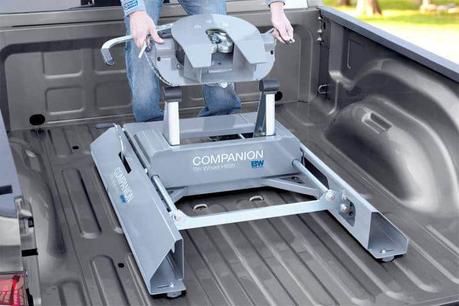
For short-bed trucks, sliding fifth-wheel hitches are essential. These hitches slide backward during tight turns, allowing the trailer to move away from the truck’s cab and preventing collisions. Short-bed trucks risk damaging their cab or trailer during tight maneuvers without a sliding hitch.
The least expensive slider hitches require a manual release to move the truck away from the trailer for tight situations.
Auto Slide Fifth Wheel Hitch
Auto slide fifth-wheel tow hitches offer short-bed truck owners a convenient, hands-free solution. These hitches automatically adjust when the turn angle exceeds a certain point, moving the truck away from the trailer. This ensures safe and smooth towing without the need for manual intervention. Auto slide hitches provide convenience and safety for those who tow frequently or in tight spaces.
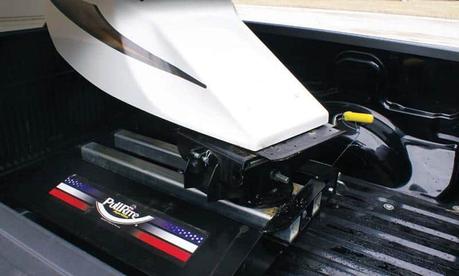
The auto-slide models provide peace of mind that you will never forget to increase the distance between the vehicles manually. Forget just once, and your rear cab window may be gone.
Heavy-duty fifth-wheel Hitch
Heavy-duty fifth-wheel hitches are necessary for towing the largest fifth-wheel RVs or trailers. These hitches offer higher weight capacities, advanced features like anti-sway technology, and improved stability. They are a must for those with luxury RVs, toy haulers, or other oversized trailers.
Fifth-wheel hitches provide superior stability and control for heavy loads. If you have a long-bed truck, a fixed fifth-wheel hitch will work well, but a sliding or auto-slide hitch is essential if you have a short-bed truck. The mounting system is another critical factor—puck systems offer more versatility, while ISR systems are more budget-friendly.
Gooseneck Hitches
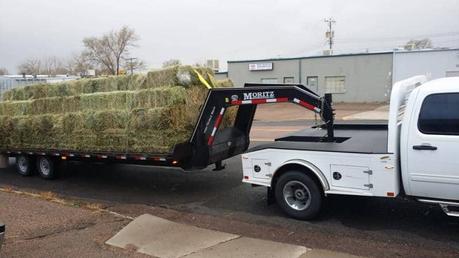
Gooseneck hitches, such as livestock trailers and large flatbeds, are commonly used for commercial towing applications. Like fifth-wheel hitches, they are mounted inside the truck bed, providing excellent weight distribution and stability. However, gooseneck hitches use a ball and coupler system instead of a coupling plate, allowing for even tighter turning radii and greater load capacities.
Types of Gooseneck Hitches
There are two primary types of gooseneck hitches: above-bed and under-bed mounts.
- Above-bed gooseneck tow hitches attach to rails mounted inside the truck bed. These rails provide a solid connection point but remain in place even when the hitch is removed, which can limit the truck bed’s usability.
- Under-bed gooseneck tow hitches are mounted below the truck bed, allowing for a flat bed surface when the hitch is not in use. This is a more versatile option for those who use their truck bed for multiple purposes, as the hitch can be removed without leaving behind rails or obstructions.
Towing Capacity and Safety
Gooseneck hitches are known for their high towing capacities, often exceeding 30,000 pounds. This makes them ideal for heavy-duty applications, such as towing livestock trailers or commercial flatbeds. The central mounting position inside the truck bed provides better weight distribution and stability than receiver hitches, making gooseneck hitches a popular choice for those hauling oversized loads.
Gooseneck hitches are overkill for most RVers but essential for towing heavy loads. A gooseneck hitch will provide the stability and capacity you need if you tow commercial trailers, livestock, or large toy haulers.
Pintle Hitches
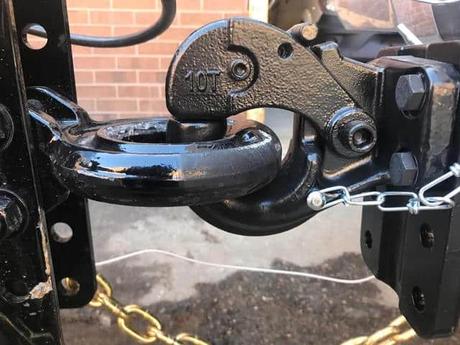
While RV owners do not commonly use pintle hitches, they play a significant role in heavy-duty and industrial towing. A pintle hitch consists of a hook and a ring system, where the hook (attached to the tow vehicle) latches onto a lunette ring (attached to the trailer). This design creates a highly durable and robust connection for extreme towing conditions.
Benefits of Pintle Hitches
- Durability and Strength: Pintle hitches are known for handling extreme loads and rough terrain. They are often used in military, commercial, and agricultural applications, where reliability and strength are paramount.
- High Towing Capacity: These hitches can handle very heavy loads, often exceeding the capacity of standard ball hitches. They are commonly found on dump trucks, construction equipment, and other industrial vehicles.
- Rugged Terrain Capability: Because of their design, pintle hitches allow for greater articulation between the tow vehicle and trailer, making them ideal for off-road or uneven terrain where other hitches might struggle.
Drawbacks of Pintle Hitches
- Noise and Play: One downside of pintle hitches is that they allow for more movement between the trailer and tow vehicle, creating noise and a rougher ride, especially on paved roads. This is one reason why they aren’t typically used for recreational towing.
- Not Ideal for RVs: Given the noise, play, and extreme nature of pintle hitches, they aren’t well-suited for RV towing, where comfort and smooth handling are priorities. However, they are an excellent option for those towing in more rugged conditions or with commercial trailers.
Pintle hitches may not be the best choice for RV owners, but they’re worth considering if you need serious towing power for rough terrain or industrial applications. They offer durability and strength that’s hard to beat in more extreme towing scenarios.
Other Considerations for Tow Hitch Selection
Selecting the right tow hitch goes beyond just choosing a type. Here are some additional factors to consider:
Weight Capacity and Ratings
Always check the towing capacity of your vehicle and hitch before selecting. Your vehicle’s Gross Vehicle Weight Rating (GVWR) and the hitch’s towing capacity should match the weight of your trailer. Overloading your hitch or vehicle can lead to serious safety risks, including poor handling and damage to your vehicle.
Every trailer has a sticker somewhere that will provide all of the required weight information that you need. It is usually inside a cabinet in the RV interior.
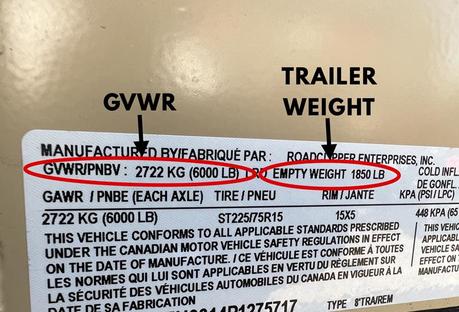
Your towing vehicle should have that information for its capacity as well. Check on the driver’s door post.
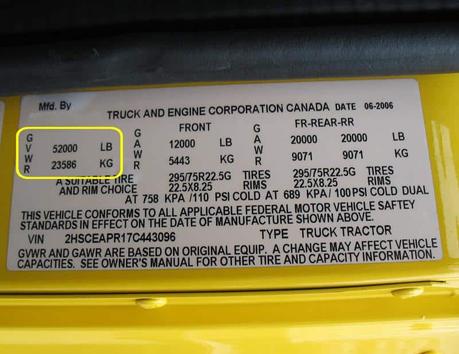
Vehicle Type
Different vehicle types require different hitch setups. SUVs and smaller trucks may only support Class I or II hitches. In comparison, larger trucks can accommodate heavier-duty options like Class III or V. If you tow a large RV or trailer, a fifth wheel or gooseneck hitch may be necessary.
One additional factor you’ll need to consider when matching a truck to a fifth-wheel or gooseneck trailer for towing is the trailer’s tongue weight. This is the amount of downward pressure the trailer exerts on the truck frame when towing. It’s generally factored at 10% of the gross trailer weight for receiver hitches. With fifth wheels or gooseneck trailers, that percentage increases to the 15% to 25% range.
This means that even if a pickup has the towing capacity to handle your fifth wheel, you may overload it and be unsafe. This will be the case if the trailer’s tongue weight (and all the other weight in the truck, including passengers) exceeds the truck’s “payload.”
Only the smallest and lightest fifth-wheel or gooseneck trailers can be towed by a half-ton pickup safely and legally. Most of those trucks would require heavy-duty towing options in addition to the standard configuration. Most fifth-wheel owners opt for ¾ ton or one-ton pickups to be safe.
Installation Difficulty
Some tow hitches are easier to install than others. Receiver hitches are often DIY-friendly, but the fifth wheel and gooseneck hitches typically require professional installation due to their complexity and vehicle-specific requirements.
Towing Comfort and Safety Features
Features like sway control and weight distribution systems can significantly enhance towing comfort. These are especially important for larger trailers, as they help prevent trailer sway and improve road stability.
Summary
Choosing the right tow hitch is crucial for a safe and enjoyable towing experience. Whether you’re pulling a small utility trailer, a large RV, or a commercial load, the type of hitch you choose will depend on your vehicle’s capabilities and your specific towing needs. Receiver hitches offer versatility, while the fifth wheel and gooseneck hitches provide additional stability for larger loads.
In my experience, investing in the right tow hitch can make all the difference. Take the time to assess your towing requirements, match them to your vehicle’s capabilities, and select a hitch that offers the safety, stability, and convenience you need for a stress-free trip.
How to Select the Right Trailer Hitch for Your Truck
